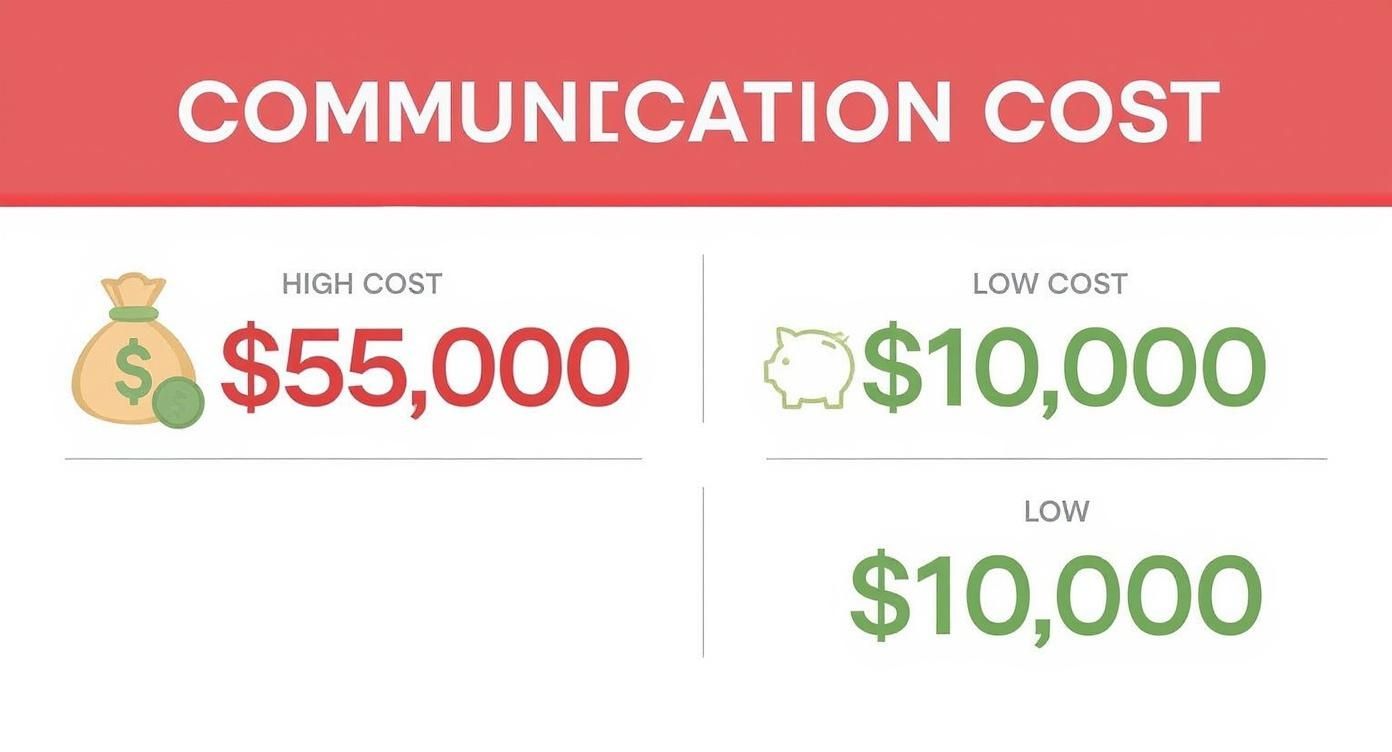Effective Communication Skills in the Workplace: Master It
Discover effective communication skills in the workplace to boost teamwork, clarity, and productivity with practical tips you can apply today.


We often talk about communication as a "soft skill," but that term doesn't do it justice. In reality, it’s a hard-hitting business competency with a massive, tangible impact on your bottom line. When communication breaks down, it’s not just awkward—it’s incredibly expensive.
The Real Cost Of Workplace Miscommunication
Let’s be blunt: miscommunication is a silent tax on productivity. Every confusing email, every misunderstood instruction, and every poorly run meeting chips away at efficiency. It leads to wasted hours, frustrated teams, and projects that go off the rails. This isn't just a hunch; the numbers back it up.
Ineffective communication is a huge financial drain on companies. One eye-opening report estimates that it costs businesses between $10,000 and $55,000 per employee annually, depending on their salary. For senior-level staff, that figure can climb to nearly $55,000 a year, all spent on rework and trying to clear up confusion. You can discover more insights from this communication study to see the full picture.
To see how this plays out, let's look at a side-by-side comparison.
The Impact Of Workplace Communication: A Tale Of Two Companies
| Metric | Company A (Poor Communication) | Company B (Effective Communication) |
|---|---|---|
| Productivity | 40% lower due to constant rework and clarification | 25% higher with clear goals and streamlined workflows |
| Employee Turnover | 50% higher attrition rates from low morale and frustration | Significantly lower rates, driven by a trusting and supportive culture |
| Project Success | 56% of projects fail to meet original goals and budget | 80% of projects are completed on time and within budget |
| Employee Engagement | Only 15% of employees are actively engaged | Over 70% of employees report being highly engaged |
| Annual Financial Cost | Estimated $37 billion lost annually for a 100,000-employee company | Substantial cost savings and higher profitability |
This table makes it crystal clear. The difference between teams that communicate well and those that don't is stark, with consequences that ripple through everything from project delivery to employee loyalty.
"The single biggest problem in communication is the illusion that it has taken place." - George Bernard Shaw
This quote absolutely nails it. Leaders think they’ve been clear, and employees believe they understand, but a chasm often exists between them. This disconnect is where tangible business problems are born.
The infographic below puts a finer point on the financial drain, breaking down the annual cost of poor communication for a single employee.

Seeing it laid out like this makes one thing obvious: investing in communication skills isn't an expense—it's an investment with a direct and substantial return.
Once you understand these costs, you start to see communication for what it is: a critical operational function. A huge piece of that puzzle is listening, a skill that’s criminally overlooked in our busy workplaces. In fact, our guide on how to improve English listening skills offers some great foundational advice that can make an immediate difference.
The good news? These skills are entirely learnable. By getting a clear picture of the problem, we can start building solutions that turn communication from a liability into your biggest competitive advantage.
The 5 Core Skills of Great Workplace Communication

Becoming a truly effective communicator at work doesn't just happen. It's a skill you build, piece by piece. The good news is that you don't need to learn a hundred different things at once. Instead, by focusing on a handful of foundational skills, you'll see a real, tangible improvement in how you connect with colleagues and clients.
Let's break down the five core pillars you can start strengthening today.
First, Master Active Listening
Real communication starts with your ears, not your mouth. Most of us are guilty of "listening to respond"—we're just waiting for a pause so we can jump in with our own point. That's not listening; it's just reloading.
Active listening is different. It’s about giving the speaker your full attention to truly understand their message, both spoken and unspoken.
A great way to think about this is the '3-Level Listening' model. Level 1 is hearing the words. Level 2 is understanding the context. But the real magic happens at Level 3, where you start picking up on the emotion and intent behind the words. Getting to that level is how you build trust and head off the simple misunderstandings that can derail entire projects.
Get Your Message Across with Absolute Clarity
In any busy workplace, confusion is the enemy. Your primary goal should be to make your point impossible to misinterpret. One of the most effective tools for this, especially in writing, is the BLUF principle: Bottom Line Up Front.
Don't bury the lead. State your most important point in the very first sentence.
- The old way: "I’ve been reviewing the Q3 project timelines and cross-referencing them with the new client feedback from last week. After analyzing the resource allocation, I have a few thoughts on potential adjustments."
- The BLUF way: "We need to move the project deadline to October 30th. This is to incorporate new client feedback without needing more resources."
This small change shows you respect everyone's time and ensures the key takeaway lands, even if they only have a moment to skim your message. This is just one of many ways to sharpen your delivery, and you can find more strategies in our guide on how to improve conversational skills.
Control the Power of Your Tone
The exact same words can be inspiring or insulting, all depending on your tone. Research has shown that tone of voice accounts for a staggering 38% of communication. In today's world of remote and hybrid work—where we live on Slack, email, and video calls—your written and vocal tone has never been more critical.
Before hitting 'send' or joining a call, take a second to ask yourself: What feeling do I want to leave them with? Whether you need to sound supportive, direct, urgent, or reassuring, making a conscious choice about your tone can prevent a world of accidental conflict.
Learn to Read the Room (And Your Own Body Language)
If tone is important, nonverbal cues are the heavyweight champion, making up 55% of all communication. This isn't just theory; it’s the real-world stuff—your posture, hand gestures, facial expressions, and how you make eye contact.
Leaning forward in a meeting signals engagement. Crossing your arms can scream "I'm not open to this," even if you're just cold.
Here's a simple truth: when someone's words and their body language don't match, people will always believe the body language.
By learning to read these cues in others, you get a much clearer picture of what's really going on. Just as importantly, becoming aware of your own nonverbal signals ensures your body is amplifying your message, not undermining it.
Give and Receive Feedback That Actually Helps
The last pillar is the art of feedback. High-performing teams are built on a foundation of open, honest, and helpful dialogue. Giving good feedback isn't about pointing out flaws; it's about offering specific, actionable observations that help people grow.
A fantastic framework for this is the Situation-Behavior-Impact (SBI) model. You simply describe the specific situation, the tangible behavior you observed, and the impact it had.
This method strips away personal judgment and focuses on facts, which makes the feedback much easier for the other person to accept and act on. Learning to use SBI to both give and receive feedback is a true mark of a communication pro.
Build Better Habits With Daily Communication Drills

Getting better at workplace communication isn’t about some grand, sweeping gesture. It’s a lot more like getting in shape—consistency beats intensity every time. Forget the heroic, all-day training sessions. The real progress comes from small, daily "workouts" that build powerful habits over time.
Think of these not as huge additions to your day, but as micro-practices you can weave into your existing schedule. They’re designed to build muscle memory and create momentum with almost no disruption.
Start With The 5-Minute Meeting Prep
Before hopping on any call, take just five minutes to get your head in the game. This one simple habit stops you from just showing up and reacting to whatever happens. You’ll shift from being a passive attendee to an active, prepared contributor.
Just ask yourself a few quick questions:
- What’s the single most important outcome I need from this meeting?
- What’s the one key point I absolutely must make or question I have to ask?
- Who am I talking to, and what do they really care about?
Answering these questions brings instant focus. It means that even if you only get a chance to speak once, your contribution will be sharp, thoughtful, and move the conversation in the right direction.
Practice The Email Clarity Check
Let’s be honest: vague emails are a huge source of friction at work. A fantastic daily drill is to read one important email out loud before you click send. Yes, it might feel a little silly at first, but it’s an incredibly powerful way to catch a confusing sentence or a tone that doesn't land right.
When you read your own words aloud, you’re forced to slow down. You'll immediately spot that awkward phrasing or the run-on sentence that makes no sense. More importantly, you'll hear if your tone comes across as harsher than intended. This simple check can save you hours of back-and-forth and prevent misunderstandings before they start. For non-native speakers, this is a game-changer; our guide on how to improve English speaking skills has even more tips for building that verbal confidence.
The goal of these drills isn't about hitting perfection on day one. It's about progress. Each tiny adjustment helps make clear, intentional communication an automatic part of who you are at work.
Try The Active Listening Rephrase
In your very next conversation, make a point to paraphrase what the other person said before you jump in with your own response. This isn’t about parroting their words back to them. It’s about showing you actually absorbed their point.
Try starting your reply with a simple lead-in:
- "So, if I'm understanding correctly, the main issue is..."
- "What I'm hearing is that you're concerned about..."
- "It sounds like the real priority here is..."
This technique is brilliant for two reasons. First, it instantly confirms you’re on the same page and gives them a chance to correct you if you’re not. Second, it makes the other person feel genuinely heard and respected, which is the foundation of any strong professional relationship. These are the small, daily habits that turn good communicators into truly great ones.
How to Steer Critical Workplace Conversations
It’s one thing to practice communication skills in theory, but it’s the high-stakes conversations that really show what you’re made of. We’ve all been there—negotiating a tight deadline, calming down an angry customer, or leading a make-or-break team meeting. These moments demand more than just knowing what to say. They require a plan.
Having a playbook for these tough scenarios is a game-changer. It’s what gives you the confidence to walk into a tense situation and handle it with grace, which lowers the stress for everyone involved. Let’s walk through a framework you can use for these crucial moments.
The Prep Work: Your Pre-Conversation Game Plan
Honestly, the most important part of a critical conversation happens before a single word is spoken. Never, ever walk into one of these situations cold.
- Know Your End Goal: What’s the one thing you absolutely must achieve? Get laser-focused on what a successful outcome looks like. If you don't know where you're going, you'll end up somewhere else.
- See It From Their Side: Seriously, put yourself in their shoes. What are they trying to accomplish? What pressures are they under? What are they likely to push back on? Understanding their perspective is your single greatest advantage.
- Map Out Your Opener: Plan your first 30 seconds. A calm, confident start immediately sets the right tone. For an unhappy customer, that might sound like, "Thank you for bringing this to my attention. My first priority is to understand exactly what happened so I can help you."
In the Thick of It: How to Stay on Track
Once the conversation is rolling, your prep work frees you up to listen more than you speak. Your job is to guide the interaction, not overpower it.
- Actually listen: Don't just wait for your turn to talk. Focus on what they're saying—and what they're not saying. Use phrases like, "So, what I'm hearing is..." to make sure you're on the same page.
- Acknowledge their reality: You don't have to agree with someone to show you understand where they're coming from. A simple, "I can see why you feel frustrated by that," can instantly de-escalate tension.
- Steer back to the goal: If things start getting sidetracked, gently pull the conversation back. "That's a fair point, and to make sure we solve your main issue, let's focus on..."
A structured approach turns a potentially volatile situation into a manageable process. It helps you separate the person from the problem and focus on finding a solution, not getting lost in the emotion.
This isn't just about making individual conversations go smoothly; it's critical for keeping your team together. A recent study found that 63% of employees thinking about quitting their jobs pointed to poor internal communication as a major reason. Satisfaction levels are all over the map, too—the finance sector feels pretty good (73% satisfaction), but logistics workers are struggling (only 30%). These numbers are a stark reminder of how much communication affects the entire business. You can read the full study on employee communication for a deeper dive.
The Follow-Through: Locking in the Outcome
The conversation isn’t truly over when you hang up or walk out of the room. This last step is what makes the resolution stick.
Always send a quick follow-up email. Summarize the key points and what you both agreed to. This simple action creates a paper trail, prevents confusion down the road, and confirms you’re aligned. A clear closing like, "I appreciate you taking the time to discuss this. I’m confident we have a solid path forward," helps rebuild trust and ends the whole interaction on a positive note.
Adapting Your Style For Remote And Global Teams
In today's workplace, your team isn’t always in the same room—or even the same time zone. That means mastering communication is no longer just about what you say, but how you navigate digital tools and cultural nuances with real intention. The old rules just don't apply when you're working across screens and continents.
Success in this new world demands a different approach. You can't rely on a shared glance or body language to add meaning to your words. Instead, clarity, tone, and empathy have to be deliberately baked into every message you send.
Bridging The Digital Divide
Remote work brings its own unique set of communication hurdles. We've all felt the video call fatigue and struggled with the ambiguity of a quickly typed Slack message. Even the "camera on or off" debate is less about preference and more about balancing engagement with personal comfort.
Learning to communicate well asynchronously is where the real magic happens. When you don't get instant feedback, your messages have to be crystal clear and self-contained. The trick is to anticipate questions and provide all the necessary context upfront, preventing that painful, momentum-killing back-and-forth.
The key to great remote communication is intentionality. Every message, email, and meeting agenda should be crafted with the awareness that you're missing the non-verbal signals of a shared physical space.
Putting in this extra effort pays off. A recent survey found that 64% of business leaders and 55% of knowledge workers agree that good communication directly improves team productivity. And it’s not just about getting work done; 79% of employees say leadership communication is critical to understanding company goals. Learn more about these powerful workplace communication statistics.
Navigating Global And Multicultural Teams
Working with people from around the world adds another fascinating layer. Cultural norms have a huge impact on how we communicate. What’s considered direct and efficient in one culture might come across as blunt or even rude in another. This is often framed as the difference between high-context and low-context cultures.
Here’s a quick breakdown:
- High-context cultures, common in many Asian, African, and Latin American countries, rely on implicit communication. The message is often found in non-verbal cues, shared history, and relationships.
- Low-context cultures, like those in the U.S., Germany, and Australia, value explicit and direct language. What you say is exactly what you mean.
Just knowing this distinction can be a game-changer. It’s also wise to steer clear of culturally specific slang or idioms that don't translate. A simple phrase like "let's hit a home run" can easily cause confusion. Your goal is to find a clear, inclusive way of communicating so that your message lands perfectly, no matter who's on the receiving end.
Your Workplace Communication Questions Answered

Knowing the theory is one thing, but putting these communication skills into practice is where the real challenges pop up. As you start using these strategies, you’re bound to hit a few snags.
This section tackles some of the most common questions and roadblocks I see people encounter when they get serious about improving how they communicate at work. Think of it as your go-to guide for getting unstuck fast.
How Can I Improve My Communication If My Boss Is A Poor Communicator?
This is a classic—and tricky—situation. You can’t force your boss to change, so you have to focus on what you can control. The secret is to build your own systems to counteract their ambiguity.
Start by modeling the clarity you wish you were getting. Be exceptionally clear and proactive in your own messages. A powerful technique is to send a follow-up email after a conversation to summarize what was discussed.
For example, you could write: "Just to make sure I'm on the right track, my understanding is that the next steps are X, Y, and Z." This creates a paper trail of clarity for everyone.
You can also learn to "manage up" by asking great questions. Instead of waiting for direction, ask things like, "What does success look like for this project?" This nudges them to give you the specifics you need without being confrontational.
What Is The Fastest Way To Build Confidence For Speaking In Meetings?
Confidence is a direct result of preparation and practice. It’s that simple. First rule: never walk into a meeting cold. Just a few minutes of prep can make a world of difference.
Before you join, jot down two or three key points you want to make. Then—and this is the part most people skip—actually say them out loud a couple of times. This builds muscle memory and helps quiet that inner critic.
Start small. Your goal for the next meeting could be to make just one valuable comment. These small wins build momentum, making it much easier to tackle bigger presentations down the line.
How Do I Give Difficult Feedback To A Coworker Without Damaging Our Relationship?
Delivering tough feedback is all about structure and empathy. You need a framework that separates the action from the person. One of the most effective I've ever used is the Situation-Behavior-Impact (SBI) model.
It keeps the conversation objective and focused. Here’s how it works:
- Situation: Pinpoint the specific "when and where." For example, "In yesterday's team huddle..."
- Behavior: Describe the observable action, not your interpretation of it. "...when you shared the client data..."
- Impact: Explain the result of that action. "...it wasn't clear how we arrived at the Q3 numbers, which caused some confusion."
Always have this conversation in private. Frame it as being in service of a shared goal, like making the team more effective. This approach helps the other person hear the feedback without getting defensive, which is crucial for preserving your working relationship.
Ready to stop just reading about communication and start practicing? TalkEasy provides a safe, AI-powered space to rehearse difficult conversations, practice your meeting talking points, and build real confidence in just 15 minutes a day. Start your journey to clearer, more effective communication at https://www.talk-easy.com.